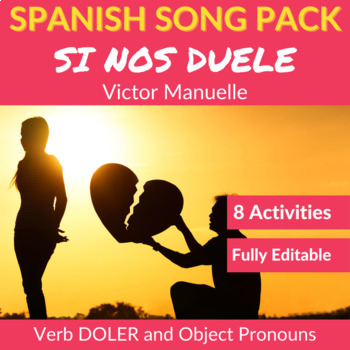
The Spanish verb “doler” is used to express physical pain or discomfort. In order to use “doler,” you need to know two things: the subject experiencing the pain, and the body part that is causing the pain.
The verb is constructed as follows: “doler” + [body part] + “a” + [subject]. For example, “Me duele la cabeza” means “My head hurts,” with “me” being the subject and “la cabeza” being the body part causing the pain.
Note that “doler” is an irregular verb, so its conjugation changes depending on the subject. To say that someone else is experiencing pain, use the appropriate pronoun instead of “me,” such as “te” for “you” or “le” for “he/she/it.”
Before learning the verb “doler” in Spanish, a student should have basic knowledge of the following:
- Pronouns: the subject pronouns in Spanish are “yo” (I), “tú” (you), “él/ella/usted” (he/she/you formal), “nosotros/nosotras” (we), “vosotros/vosotras” (you all informal, only used in some countries), and “ellos/ellas/ustedes” (they/you all formal). It’s important to know how to use these pronouns correctly when conjugating verbs.
- Present tense conjugation of regular verbs: the present tense is used to talk about actions that are happening right now or that happen regularly. Spanish verbs have different endings depending on the subject pronoun. It’s important to know how to conjugate regular verbs in the present tense before learning “doler.”
- Vocabulary related to body parts: “doler” is a verb that is used to talk about pain in different parts of the body. Therefore, it’s important to know the names of different body parts in Spanish, such as “cabeza” (head), “espalda” (back), “brazo” (arm), “pierna” (leg), etc.
- Indirect object pronouns: “doler” is an example of a verb that requires an indirect object pronoun. The indirect object pronoun in Spanish indicates who is affected by the action of the verb. In the case of “doler,” the indirect object pronoun is used to indicate who is experiencing the pain. The Spanish indirect object pronouns are “me” (to/for me), “te” (to/for you), “le” (to/for him/her/you formal), “nos” (to/for us), “os” (to/for you all informal), and “les” (to/for them/you all formal).
Once the student has a basic understanding of these concepts, they should be able to learn and understand how to use the verb “doler” in Spanish.
Verb DOLER Spanish Lesson Plan, Practice Song, and Resource Sheet
Next is a Spanish lesson plan for beginner students and a song to practice the verb DOLER. Also check the resource sheet with additional resources for your classes.
 Body Parts and Health Vocabulary: DOLER and Indirect Object Pronouns Lesson Plan for Spanish 1 – At the end of this activity, students will have reviewed and used parts of the body and specific health vocabulary. Students will also review and use indirect objects to talk about feeling sick.
Body Parts and Health Vocabulary: DOLER and Indirect Object Pronouns Lesson Plan for Spanish 1 – At the end of this activity, students will have reviewed and used parts of the body and specific health vocabulary. Students will also review and use indirect objects to talk about feeling sick.
 Spanish Song: Si nos duele by Victor Manuelle: Verb DOLER and Object Pronouns – This activity pack includes: full song lyrics, 2 cloze activities, verb vocabulary match, verb doler worksheet, Broken Heart Tweets activity, pronouns me, te and nos worksheet, sentences with pronouns worksheet and answering pronouns me, te and nos worksheet.
Spanish Song: Si nos duele by Victor Manuelle: Verb DOLER and Object Pronouns – This activity pack includes: full song lyrics, 2 cloze activities, verb vocabulary match, verb doler worksheet, Broken Heart Tweets activity, pronouns me, te and nos worksheet, sentences with pronouns worksheet and answering pronouns me, te and nos worksheet.
